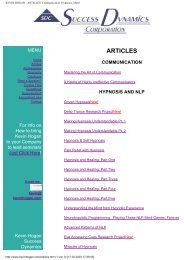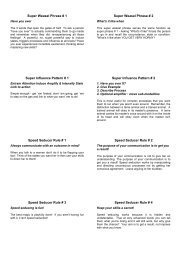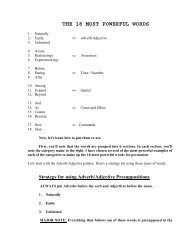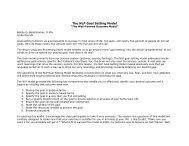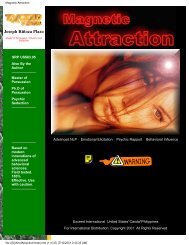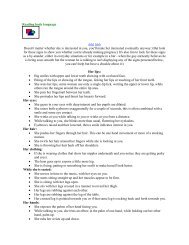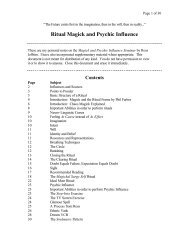A Pragmatic Guide To Communication & Change.pdf - NLP Info Centre
A Pragmatic Guide To Communication & Change.pdf - NLP Info Centre
A Pragmatic Guide To Communication & Change.pdf - NLP Info Centre
- No tags were found...
Create successful ePaper yourself
Turn your PDF publications into a flip-book with our unique Google optimized e-Paper software.
This ability to operate in systems other than the preferred system is true for all of the<br />
communication categories.<br />
Figure 2 - 1<br />
53<br />
other categories. When operating from this modality, people tend to breathe into the<br />
lower portion of the lungs. The tonality of a "kino" might be generalized as having soft or<br />
airy qualities with a slower tempo and lower tone and volume than the other categories.<br />
Figure 2 - 2 illustrates this category.<br />
Body: Brief Analysis<br />
If you think in terms of the aspect of experience the habitual "kino" or "visual" is<br />
paying attention to, the structure of their bodies begins to make sense. When<br />
operating from the visual modality, a person becomes dissociated or disconnected<br />
from bodily experiences. This is because it is primarily the visual portions of the<br />
environment that command his attention. Physical demands such as hunger (or<br />
fullness!) often go unnoticed, and, though habitual "visuals" tend to be slimmer<br />
than people whose preferred system is kinesthetic, they can also become obese.<br />
Unlike the "visuals," habitual<br />
"Kinos"<br />
Think of the image evoked by Santa Claus. He is always depicted as a soft and rather<br />
round man with rosy cheeks and a flowing white beard. When he laughs, his whole belly<br />
jiggles, and the feelings he elicits are warm and happy.<br />
The figure of Santa is an appropriate example of a "kino." The habitual "kino" generally<br />
has more flesh on his body than individuals from the other categories, although they tend<br />
not to be obese. When communicating from this modality, individuals will often<br />
demonstrate a rounding of the shoulders, and they sometimes bend slightly forward as<br />
they speak and listen. Their motions tend to be flowing and loose; how else would Santa<br />
get down the chimney! Habitual "kinos" often have a larger rib extension compared to the<br />
50<br />
It is important to keep in mind throughout this book the warning previously issued. This<br />
model and the labels associated with it are only generalizations about people. They delete<br />
a great deal of information; this is a part of how they are supposed to function. They can<br />
make it easier for us to perceive, understand, and predict behavior. However, as<br />
mentioned in a popular text on psychology, "Labels intended to be merely descriptive<br />
may also come to be regarded as explanations of the problem."' 2 They should never be<br />
used in a way which might interfere with either our perceptions of or our hehnuiors<br />
toward those we have labeled. The examples in the sections which follow are intended to<br />
simplify the task of detecting behavioral patterns. Ilowever, remember that it is always<br />
best to use your own observations when a model doesn't tit.<br />
The <strong>Communication</strong> Categories Model Outline<br />
The following list represents the specific areas of behavior covered by the<br />
communication categories model. These behaviors are different for each of the<br />
four systems and are described in detail in the text. A complete chart with specific<br />
behaviors listed under the "visual," "kino," "tonal," and "digital" systems is<br />
presented in Appendix C.<br />
1. Predicates which presuppose a representational system (preferred system).<br />
2. Postural characteristics.



